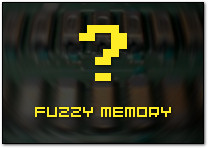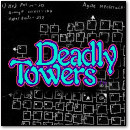April 9th, 2012 by Benj Edwards
 This makes me want to watch Top Gun for some reason.
This makes me want to watch Top Gun for some reason.
This magazine ad for Accolade’s Grand Prix Circuit (1988) reminds us of a time when folks were less kind to their hair — and when sunglasses engulfed half of your face.
It also reminds me of how wonderful it was when racing games switched to polygon-based graphics. If any video game genre benefited most from the shift from sprites to 3D polygons, it was racing. I mourned the loss of 2D pixel art in just about every game style except racing games, where the freedom of movement afforded by 3D environments heralded a new dawn for the genre.
[ From Compute’s Gazette for Commodore Users, December 1988, p.2 ]
Discussion Topic of the Week: What did your hair look like in the 1980s? Bonus points if you can link to a 1980s photo of yourself!
Posted in Computer Games, Gaming History, Regular Features, Retro Scan of the Week, Retrogaming | 6 Comments »
April 2nd, 2012 by Benj Edwards
 You can’t tell from the photo, but this table is actually 200 feet wide.
You can’t tell from the photo, but this table is actually 200 feet wide.
Since I bought my first Model 100 over a decade ago, I’ve always wanted the TRS-80 Model 100 Disk/Video Interface (a device we see here in this 1984 advertisement) to go with it. The interface not only allows you to hook your Model 100 to a TV set or monitor (80 x 25 text display!) but it also provides two floppy disk drives on which you can store your data.
In other words, that’s quite an expansion for a computer with an 8 x 40 character display and minimal RAM-based user storage that loses its contents with battery failure. It essentially converts the Model 100 — which is a light, portable machine — into a desktop PC.
[ From BYTE Magazine, April 1984, rear cover ]
Discussion Topic of the Week: Have you ever set up a desktop computer on your kitchen table? Tell us about it.
Posted in Computer History, Regular Features, Retro Scan of the Week, Vintage Computing | 10 Comments »
March 26th, 2012 by Benj Edwards
 Tiger Game.com Internet Module Box
Tiger Game.com Internet Module Box
Two years ago, I posted a scan of the Tiger Game.com instruction manual. Today, I bring you the box for that console’s little-understood Internet cartridge, released in 1997.
The box you see above included a Game.com serial cable (which allowed the console to be hooked up to an external RS-232 Hayes compatible PC modem) and a cartridge with the “Internet” software on it. In truth, the cartridge contained little more than ASCII text-based terminal emulator software.
In my previous Game.com Retro Scan, I described the Game.com’s Internet connectivity, which I will quote below:
The Internet on the Game.com wasn’t nearly as exciting as it sounds. Sure, it supported “checking your email” and uploading high scores to the Tiger website, but a user had to access the ‘Net through a text-only terminal emulator cartridge — and then only via a serial cable that linked to a stand-alone dial-up modem.
It was a messy business. Being text-only, the user had to type in commands to whatever ISP the user chose (assuming they provided shell access) with the stylus on a tiny on-screen keyboard. Tiger did provide its own ISP that made the process slightly more user friendly. While far from practical, having a terminal emulator was an amusing capability. I used the Game.com call some BBSes around in 1997 for a chuckle.
As you can see, the Game.com’s Internet feature wasn’t very practical or useful, but it certainly serves as an amusing footnote in game console history.
By the way, Tiger once offered (or planned to offer) its own Tiger brand external modem for use with the Game.com. I’m not sure if it ever made it intro full production, but it is extremely rare either way. If anyone out there has seen one, please let me know.
[ From Tiger Game.com Internet box (module 71-529), circa 1997 ]
Discussion Topic of the Week: What was the first video game console you bought that could communicate with the Internet?
Posted in BBS History, Gaming History, Internet History, Regular Features, Retro Scan of the Week, Retrogaming, Vintage Computing | 3 Comments »
March 19th, 2012 by Benj Edwards
 That must be one heck of a spreadsheet you’re working on.
That must be one heck of a spreadsheet you’re working on.
[ From Marlin P. Jones and Associates Electronics Catalog, 2000 ]
Discussion Topic of the Week: Do you prefer playing classic PC games (say, pre-Doom) using a keyboard, a mouse, or a joystick?
Posted in Computer Games, Computer History, Gaming History, Regular Features, Retro Scan of the Week, Retrogaming, Vintage Computing | 14 Comments »
March 12th, 2012 by Benj Edwards
 It’s the MICRO EXECUTIVE WORKSTATION, people!
It’s the MICRO EXECUTIVE WORKSTATION, people!
iPad, schmyepad. In the 1980s, we had hair on our chests, far fewer seat belts, and we walked backwards downhill halfway from school every day in the monsoon season. AND WE LIKED IT. We also used the TRS-80 Model 100 — a sleek 3.9-pound, 2-inch thick machine that could run 20 hours on a single set of four AA batteries — for all of our mobile computing needs.
Imagine 8 kilobytes of RAM. Imagine a full travel keyboard and a 240×64 display that could fit in your lap. Imagine downloading stock prices at $12/hour from CompuServe at 300 bits per second over two acoustic couplers. It’s not a fantasy — it’s life in 1983.
Below, I present for your perusal a stat-by-stat comparison between the mighty Radio Shack wonder and today’s iPad, then I ask you: which is truly superior?
[ Continue reading [ Retro Scan of the Week ] The iPad of the 1980s » ]
Posted in Computer History, Regular Features, Retro Scan of the Week, Technology Commentary, Vintage Computing | 19 Comments »
March 12th, 2012 by Benj Edwards

Over the weekend, PCMag.com published a slideshow I put together covering 10 classic computer RPGs of the 1980s. Here is a passage from the introduction that excited Slashdot recently:
Throughout our story, we’ll cover 10 classic computer games that both defined and extended the definition of the RPG in the 1980s. You’ll see names like Ultima, The Bard’s Tale, and Might and Magic, which may seem familiar, but you’ll also find a few surprising titles that you may never have heard of.
It’s funny — I was going to try to sneak this one past the Internet populace with a modest, unassuming title instead of something like “THE TEN MOST IMPORTANT RPGS OF THE 1980S.” But nooo, someone found it anyway, dug out the interesting kernel of truth buried in the introduction, and put it on Slashdot for all to see.
I bet if I had titled it something like “10 Games,” we would be hearing about it on the CBS Evening News tonight.
All that being said, I hope you enjoy it.
Read “10 Classic Computer RPGs” at PCMag.com
Posted in Computer Games, Computer History, Gaming History, Humor, Retrogaming, Vintage Computing | 3 Comments »
March 5th, 2012 by Benj Edwards
 Why 146 simultaneous colors? Because it’s one more than 145!
Why 146 simultaneous colors? Because it’s one more than 145!
I previously wrote about the Neo Geo Pocket Color in a Retro Scan of the Week from 2010, but I ran across this colorful 1999 ad for the console recently and couldn’t resist. I’ve always had a soft spot for this would-be Game Boy killer that never lived up to its true potential.
[ From Electronic Gaming Monthly, September 1999, p.219 ]
Discussion Topic of the Week: Why do you think the Neo Geo Pocket Color failed to achieve long-term success?
Posted in Gaming History, Regular Features, Retro Scan of the Week, Retrogaming | 5 Comments »
February 27th, 2012 by Benj Edwards
 The Amaray Corporation DiskBank Media Mate
The Amaray Corporation DiskBank Media Mate
It’s not every day that I stop and think about floppy diskette storage boxes. I never had a favorite brand of them, but I did find fault with many of the designs I encountered over the years. My least favorite thing about the DiskBank-stye box is if you pick it up by its “handle” (as illustrated here) without locking or properly latching the lid, the lid flops open and you end up with a pile of floppies on the floor.
It would be interesting to catalog and put together a historical timeline of floppy disk box brands…but then again, I don’t see myself doing that any time soon.
[ From BYTE Magazine, April 1984, p.149 ]
Discussion Topic of the Week: What kind of containers do (or did) you use to store your floppy disks?
Posted in Computer History, Design, Regular Features, Retro Scan of the Week, Vintage Computing | 15 Comments »
February 21st, 2012 by Benj Edwards
 Every once and a while, I receive emails from people looking for a certain game, electronic toy, or computer from their distant past. I then pass it on to intrepid VC&G readers to crack the case.
Every once and a while, I receive emails from people looking for a certain game, electronic toy, or computer from their distant past. I then pass it on to intrepid VC&G readers to crack the case.
The Clues
Jakdin writes:
Hi there,
I have been trying to remember the name of a C64 (possibly C128) text adventure game that I played in 1989 or 1990. I don’t remember the game containing any visuals, but there might have been… Regardless, here’s what I remember, and it’s not much, of the game content:
You are a detective (I believe) and are at a seaside or lakeside resort during it’s off-season time. I remember that I could “see” an abandoned row boat and closed/locked market along the water.
That’s all I vividly remember. Not so clear is the possibility of other shut or closed down stores and buildings in the vicinity of where the game starts the player.
Any help at all in finding the title of this game from my vague memory would be MUCH appreciated!
Thanks!
jakdin
The Search Begins
It’s up to you to find the object of Jakdin’s fuzzy memory. Post any thoughts or suggestions in the comments section below. Jakdin will be monitoring the comments, so if you need to clarify something with him, ask away. Good luck!
—
Have a memory of a computer, video game, computer software, or electronic toy you need help identifying? Send me an email describing your memories in detail. Hopefully, the collective genius of the VC&G readership can help solve your mystery.
Posted in Computer Games, Computer History, Fuzzy Memory, Gaming History, Regular Features, Retrogaming, Vintage Computing | 7 Comments »
February 20th, 2012 by Benj Edwards
 Three years before the Game Boy Color, Nintendo released color Game Boys.
Three years before the Game Boy Color, Nintendo released color Game Boys.
[ From Nintendo Power, April 1995, rear cover ]
Discussion Topic of the Week: Name every color of every Nintendo handheld console you’ve ever owned (any kind).
Posted in Gaming History, Regular Features, Retro Scan of the Week, Retrogaming | 15 Comments »
 This makes me want to watch Top Gun for some reason.
This makes me want to watch Top Gun for some reason.






 Every once and a while, I receive emails from people looking for a certain game, electronic toy, or computer from their distant past. I then pass it on to intrepid VC&G readers to crack the case.
Every once and a while, I receive emails from people looking for a certain game, electronic toy, or computer from their distant past. I then pass it on to intrepid VC&G readers to crack the case.





